And here we get to some of the designs that can be considered “kinda big.” First up is the “Enzmann Starship.” It seems to have caught the imagination of a notable fraction of the space-nut population in the early 1970’s; it certainly looked like the first practical, well-thought-out manned starship design. And while a fair deal of really good art and diagrams was produced, the numbers… they don’t seem to add up so well. It’s been a challenge to determine just how much engineering rigor went into this design. The C-size drawing for this beast is 1/2400 scale.
And here is yet another one from Dandrige Cole, an internal-nuclear pulse vehicle that was meant to be a wholly self-supporting space colony, on the same order of size as Babylon 5. But able to move itself about. C-size drawing is 1/6000 scale.
The next step up is also a step down. Johndale Solem’s Medusa is a recent design for an Orion-type craft that uses a lightweight spinnaker instead of a solid pusher plate; in order to gain enough distance from the nuclear detonations so that the plastic cables and “sail” don’t get fried by the nuclear radiation, the dimensions are measured in kilometers. But the core vehicle itself is relatively really quite small. The scale on the C-size drawing is 1/30,000.
And last up is far and away the largest space vehicle that I’ve ever seen seriously considered (at least that I can recall). It is a Bond/Martin design for a nuclear-pulse-propelled “world ship,” big enough to carry complete ecosystems on journeys lasting millenia, to colonise and terraform alien worlds. While the design is admittedly wholly hypothetical, and was meant more as an excercise to see what might be possible with a vaster industrial infrastructure but with physics and engineering we know today, the math behind the concept seems sound, and is more detailed than many other designs I’ve seen.
The C-size drawing is scaled at 1/600,000.
Note in the closeup of the engine section that the largest of the other vehicles are mere specks in comparison. In fact, even though the acceleration was a small fraction of a G, and would have lasted for decades, the pulse units themselves would have been astounding feats of engineering. More massive than the Orion Battleship, each pulse unit would have had a yield measured in *gigatons.* One every five seconds.
Two versions were contemplated… a “dry world” with a large hollow rotating cylinder with a terrestrial ecosystem on the inside; and a “wet world” with a much smaller cylinder, sized to support an ocean a kilometer deep (perhaps overly deep, IMO). The “wet world” would have, unsurprisingly, been notably more massive, and would have required the greatest propellant supply and most powerful (34+ gigaton) pulse units, massing over 7,000 tons each.
That little purple line? Fifty kilometers.
With the possible exception of the Medusa, these designs are well beyond our current capabilities. But a damned good way to improve our capabilities is to have something to strive for. Spacecraft such as these can fire the imagination in a way that rinky-dink little capsules cannot. Spacecraft so large that they have their own weather, that can carry not just humanity but all the forms of life on Earth, to other solar systems… how can you look at that and not be inspired, even if just a little bit?
Far more info than this, on far more projects than these, will be presented in the “Nuclear Pulse Propulsion” book.
20 Responses to “Giants In The Sky, Part 2”
Sorry, the comment form is closed at this time.
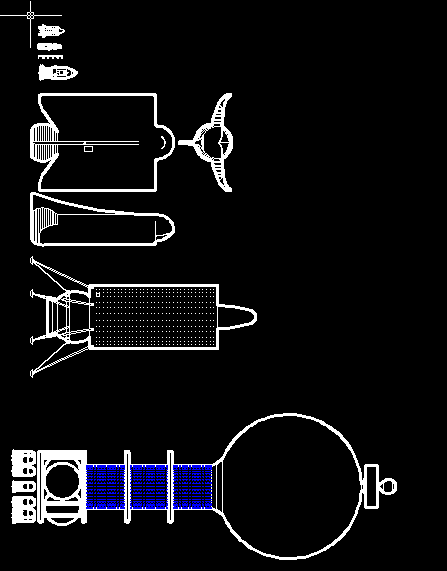
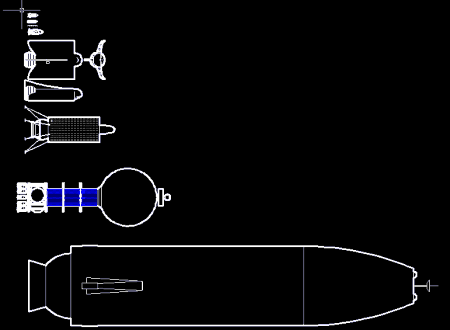
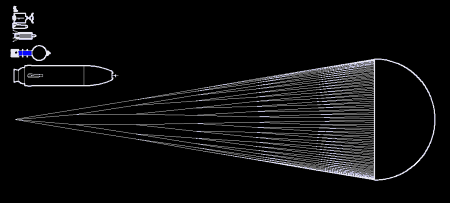
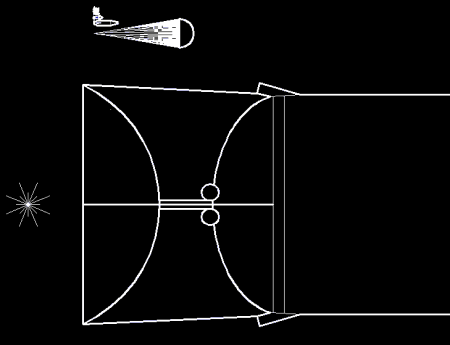
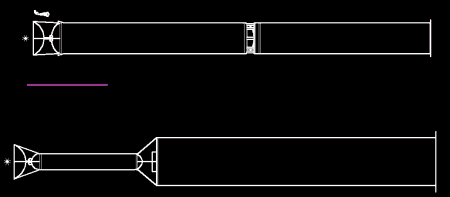
Damn Scott,
Really looking forward to the book.
This is really the opposite end of the scale from cubesats.
(ie anything I can afford)
-Gar.
That’s a lot of U-235.
I can not wait till the book comes out – inspirational in the least.
Considering that the whole reason I stumbled upon your blog was a love of NPP, is there any sort of price range that this book is expected to fill upon release? I’ll need to know how much I should keep tucked away until then.
> That’s a lot of U-235.
None at all, in fact.
What do they use to set off the 34Gt nukes?
I need to research some of their references to see if it is truly workable, but the idea is simple enough. The way a fusion reaction happens in the Sun is a combo of heat and pressure overcoming nuclear repulsive forces. The way humans have replicated these conditions on Earth have included using fission bombs, or big-ass lasers firing at tiny, tiny deuterium targets. But if you have ships hundreds of KM long, dealing with a propulsion system that has a power output measured in gigatons/second, you have a *lot* of space, mass and power to play with. You could install a mass driver capable of tens of thousands of gees, and miles long. Enough to fling an aluminum or steel projectile as a speed of 1000 to 2000 km/second. A projectile which would hit the deuterium “trigger” in the pulse unit so hard that the shockwave would replicate the temperature & pressure at the center of the Sun.
I have vague recollections of reading about such “mechanical” fusion systems before, possibly in Winterberg, but it’s been a long while. In any event, it’s the sort of system that would suck as a weapon, and would not scale down very well.
>I have vague recollections of reading about
>such “mechanical” fusion systems before, possibly in Winterberg,
German theoretical physicist Burkhard Heim proposed it fist
In 1943 he talk with Heisenberg about the use of chemical implosion
to make a “clean” H-bomb
http://en.wikipedia.org/wiki/Burkhard_Heim
Wow.
I am inspired – to say what a complete and utter waste of resources these craft would be.
I must admit, the irony of someone bitching about important forms of travel and ecosystem expansion, when they themselves are the result of exactly that, is really quite staggering.
Something on Medusa
https://jour.space/issues/issue-2-2015/
https://www.centauri-dreams.org/?p=38184
One could suggest that those who propose that we should “inherit the stars” are merely proving George Santayana’s famous quote true.
> merely proving George Santayana’s famous quote true
Yes. Those who don’t remember the history of the denizens of Easter Island are doomed to repeat it.
On the other end of the spectrum, those who remember Manifest Destiny will remember that it helped create the greatest nation in the history of Earth.
Greatest? According to whom? Its victims or its inhabitants? You don’t think the views of either may be rather prejudiced? “Manifest Destiny” was merely an attempt at selling imperialism under a different name.
If we cannot manage the resources of their environment, why should we be inflicting our rapacious and profligate species on other planets?
> Greatest? According to whom?
Reasonable people. Those who can look at what countries have done, good and bad, and weigh them. Those who can look at migration patterns and realize that a whole *lot* of people sure want to be a part of one country.
> why should we be inflicting our rapacious and profligate species on other planets?
Because planets don’t give a rats ass what you do with them. What, do yo think that the “soul” of Ceres really cares if we strip mine it, and turn it into a million space habitatats that we fill with humans, kittens, puppies, bunnies and blue whates?
I care. Many other people care. We worry about what sort of planet people like you will allow us to hand onto our children. Of course, if you don’t have children and don’t plan to have children then you might not understand that sentiment, preferring to live an existentialist existence.
As to migration patterns, Meh. Many factors create them. Not all economic. Speaking of economic issues, the US seems to be having its rather large share of economic problems brought on by the sort of existentialist mentality you like to blather on about. Does that make it “great” still? Or do you just sweep such embarrassing ideas under the carpet when extolling its virtues?
The reality is that the US has gotten to its present position at the top of the poll by trampling on everybody else around the world. If it can’t buy it, it steals it. If it can’t steal it, it just kills everybody and steals it anyway.
> We worry about what sort of planet people like you will allow us to hand onto our children.
Worry not. I’m a capitalist. Compare the cleanliness of captialist environment to that of collectivist environments. The worst of ours is kinda like the best of yours. Consider air quality, or nuclear disasters: with collectivists, you get exploding nuclear reactors that spread lethal doses of fallout over thousands of square kilometers; with capitalists, you get reactor failures that realease virtually no radiation and injure nobody.
> the US seems to be having its rather large share of economic problems brought on by the sort of existentialist mentality you like to blather on about.
Yes, i do like to blather on about leftists.
> Does that make it “great” still?
The sweeping adoption of such leftwinger laws that brought about the housing/banking collapse have damaged the US mightily, it’s true. We are not what we once were. But nobody else seems to be much better off.
> The reality is that the US has gotten to its present position at the top of the poll by trampling on everybody else around the world. If it can’t buy it, it steals it. If it can’t steal it, it just kills everybody and steals it anyway.
It must be interesting to be so credulous as to easily believe such rubbish.
The Bond Martin worldship was featured last night on Evacuate Earth:
http://channel.nationalgeographic.com/channel/episodes/evacuate-earth/
I would think the soil might be dislodged if the pulses were too sharp. Here this ship was 15 km I think, not 50.
There the gov’t sponsored ship worked, but the rival one-percenter ship exploded. In truth, we want as many ships as possible to work.
We see more of the worldship here:
http://www.bis-space.com/products-page/magazines-and-journals/spaceflight-magazine/spaceflight-vol-53-no-11-november-2011/
[…] of the bomb and the resultant blast, these would seem to be perfect fits for Johndale Solems “Medusa.” They would also work for propulsion systems with parabolic “pusher plates,” […]